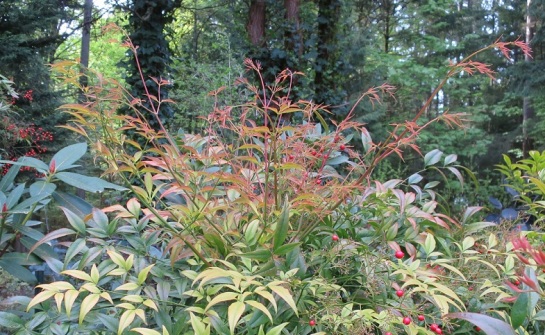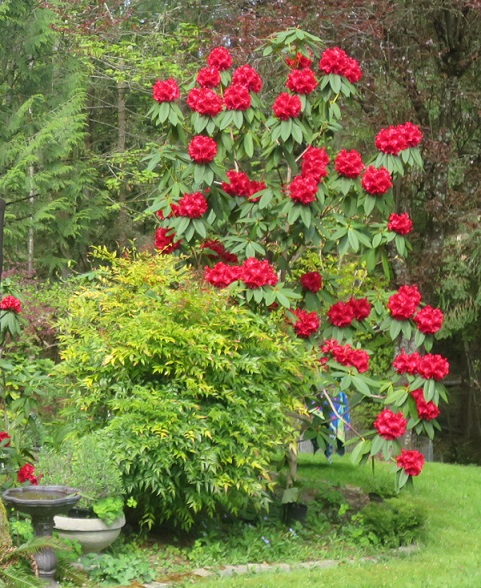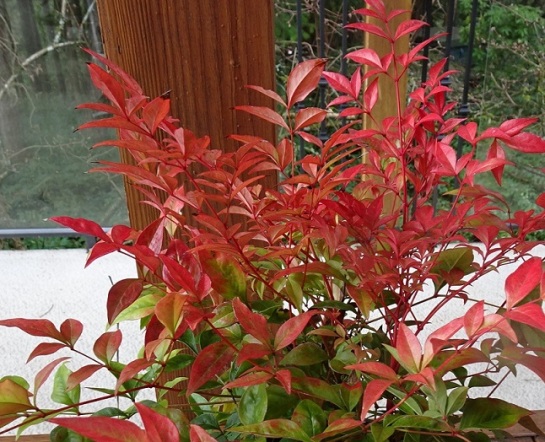Nandina Domestica (Heavenly Bamboo)
What I have learned about this plant:
Regardless to it’s name “Heavenly Bamboo”, this plant is not a bamboo relative. Botanically, Nandina Domestica is a member of a barberry family (Berberidaceae). The botanical name Nandina is a Latinized version of the Japanese name Nanten. (domestica means cultivated). The word bamboo was used probably because of the plant appearance of slender upright statue and bamboo like leaves …..It does not spread like bamboo.
This elegant shrub is evergreen on this island and I planted several on this property. The plant is generally grown for its spectacular foliage. The leaves start off as pink or reddish, then go through various shades of green in the spring and turning to shades of amber, orange, purple, copper and red as the winter approaches.
Nandinas are incredibly shade tolerant and drought tolerant. A great plant for the right place.,
Nandina is frequently planted in gardens in Japan and was brought to Western gardens by William Kerr, who sent it to London in 1804 (note from Wikipedia.)
During the Edo Period (1603-1868), the Japanese developed nearly 200 cultivars (cultivated varieties) of Nandina and growing it became a speculative enterprise for a period of time (like tulip version in Holland) . Today, Japan records 65 named varieties .
In Japanese symbolism the aesthetic beauty of the plant was important but its associations were of equal importance. In Japanese kanji script, ( Chinese characters) it means “hardship reversal.” A Nandina is also a typical gift for a new homeowner (as a symbol of good luck) for the newly established household to protect it from harm, often planted next to buildings and doorways.
Nandina is popular in traditional decorations . Its leaves, flowers and berries are used in ikebana, a Japanese art form in which branches, leaves, grasses and flowers are placed in a vase according to long established rules .
It also have a role in Japanese and Chinese New Year celebrations .
The woody stems of the plant have been used in China to make chopsticks.
Next picture is a Nandina on our property in 2020. It responded to serious ” hair cut” in previous fall well.
in the US South, Nandina is labeled as an invasive plant. It’s not an environmental hazard in our region.
In poems associated with this plant the words are all about happiness . Never the death was mentioned until it was reported that in quantity the berries are toxic to birds. In the original report from April 2009, several dozen cedar waxwings were found dead in a garden in Thomas County, Georgia. Their bellies were full of the ripe berries of Nandina domestica, which contains small amounts of cyanide (similar to the amount found in apple seeds) and other alkaloids.
This was the first documented instance of harmful toxicity, and I haven’t been able to find any other published document since. However, on the basis of this single (well-documented) report , Nandina is getting a bad rap.
We can read in various publications that the bitter dried fruit is used as a cough suppressant in the traditional Chinese medicine. And tree bark and roots is used for the medicine of eye disease and stomach disorder.
Found this on the web:
“Every variety of bird visited this garden at its appointed time of year, but nothing could compare to the numbers in the migration season when flocks of birds swooped down from the sky to peck at the nadine fruits and the insects in the broad expanse lawn.”
from “After the Banquet” by Yukio Mishima translated by Donald Keene …….
Berries of Nandina Domestica
Detail
Nandina domestica shown here on our property with showy rhododendron Taurus in April
Grazing animals seem to be able to detect the toxins and therefore avoid these plants. Our deer will not touch it but Robins will nibble on its berries so I usually cut the sprays off before winter comes.. They look wonderful in the vase. Both the foliage and the berries make great additions to winter arrangements.
There are some cultivars that have been bred to be sterile (no berries) such as Gulf Stream and are apparently reliable, long-lived and handsome year round. On an average Nandina matures to 5 feet high and wide but one of mine is taller than 6feet and narrower than 4 feet.
Colour of my new Gulf Stream’s fresh foliage .
The cultivar named ‘Obsession’ grows only to 2 (2and1/2) and its new growth is even more vibrant red than Gulf stream’s.
It’s the one I will have to have in time.
===========================================================================================
Found on the web:
These are some of the popular cultivars of this plant:
- Blush – Slightly smaller than the above, it produces red new growth in spring and autumn, and in winter months it turns vivid red.[9]
- Fire Power – Height of 2 to 2 1/2 feet tall, is so-named for its impressive red fall and winter foliage.[10]
- Gulfstream – Reaching 3 feet wide and 3 to 3 1/2 feet tall, it displays orange-tinted, coppery young foliage that developed to turquoise in summer, then turns orange-red in fall.[10]
- Lemon Lime – Yellowish green spring foliage that transforms to chartreuse in summer.[10]
- Moon Bay – Dense and upright reaching 1m, its foliage change seasonally from lime green, red, apricot and burgundy.[11]
- Moyer’s Red – A semi dwarf type that grows 4 to 6 feet tall that features light-pink flowers.[12]
- Nana – A dwarf variety suited for a low hedge,
- Nandina domestica ‘Nana Purpurea’ which grows 60cm(2 ft) which I think are best in containers as they do not have the elegant form as the full-sized ones it features foliage that turns into lime green to crimson red and scarlet-bronze tones in the cooler months.[13]
- Obsession – Related to the above, it grows 2 to 2 1/2 feet tall and wide and features scarlet spring and fall foliage.[10]
- Royal Princess – Reaching up to 8 feet tall, this displays blush-coloured blooms.[10]
- Sienna Sunrise – Growing 3–4 feet tall, it features glaring red foliage with red highlights in fall.
- =============================================================================================.
Happy Easter 2020 ( keep safe)







